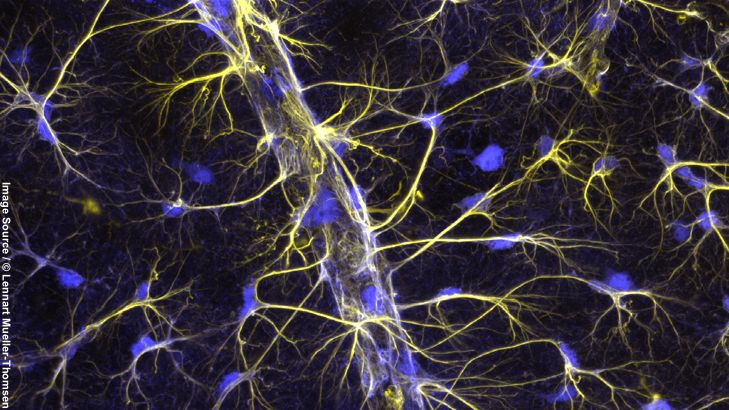Prof. Dr. Christine R. Rose
Promotion; Habilitation im Fach PhysiologieProf. Dr. Christine R. Rose studierte Biologie an der Universität Konstanz mit dem Schwerpunkt Tierphysiologie und erwarb 1990 ihr Diplom. Nach der Promotion an der Uni Kaiserslautern arbeitete sie von 1994 bis 1997 als Postdoc im Department of Neurology der Yale University (U. S. A.). Es folgten Anstellungen an der Universität des Saarlandes sowie der TU und der LMU in München. Ihre Habilitation legte sie 2002 im Fach Physiologie an der LMU München ab in der sie bis 2005 als Heisenberg-Stipendiatin der DFG blieb. Seit 2006 ist Prof. Rose Leiterin des Instituts für Neurobiologie der Heinrich-Heine Universität Düsseldorf. Seit 2012 ist sie Mitglied im Fachkollegium Neurowissenschaften der DFG und Ko-Koordinatorin der Internationalen Graduiertenschule (iBrain) sowie -seit 2014- des DFG-Schwerpunktprogramms 1757 ("Glial Heterogeneity"). Ihre wissenschaftlichen Interessen liegen in der zellulären Neurophysiologie, insbesondere in aktivitätsinduzierten Ionensignalen in Neuronen und Glia.
Arbeitsschwerpunkt:
Zelluläre Neurobiologie
Ausbildung:
Studium der Biologie in Konstanz
Abschluss:
Promotion; Habilitation im Fach Physiologie
Position / Tätigkeit:
Leiterin des Instituts für Neurobiologie
Homepage:
http://www.neurobiologie.hhu.de/leitung-institut.html
Auswahl neuerer Arbeiten:
1. Karus C, Mondragão M, Ziemens D & Rose CR (2015): Astrocytes restrict discharge duration and neuronal sodium loads during recurrent network activity. Glia. 2015 Jan 29. doi: 10.1002/glia.22793. [Epub ahead of print]
2. Hertz L, Gerkau NJ, Xu J, Durry S, Song D, Rose CR, Peng L (2014): Roles of astrocytic Na+,K+-ATPase and glycogenolysis for K+ homeostasis in mammalian brain. J Neurosci Res. 2014 Oct 29. doi: 10.1002/jnr.23499. [Epub ahead of print]
3. Kleinhans K, Kafitz KW, Rose CR (2014): Multi-photon intracellular sodium imaging combined with UV-mediated focal uncaging of glutamate in CA1 pyramidal neurons. J. Vis. Exp. (92), e52038, doi:10.3791/52038.
4. Haack N, Dublin P & Rose CR (2014): Dysbalance of astrocyte calcium under hyperammonemic conditions: PLoS One. 2014 Aug 25;9(8):e105832. doi: 10.1371/journal.pone.0105832.
5. Schreiner AE, Durry S, Aida T, Stock MC, Rüther U, Tanaka K, Rose CR, Kafitz KW (2014): Laminar and subcellular heterogeneity of GLAST and GLT-1 immunoreactivity in the developing postnatal hippocampus. J Comp Neurol, 522(1):204-24.
6. Karus C & Rose CR (2013) Two sides of the same coin: Sodium Homeostasis and Signaling in Astrocytes under physiological and pathophysiological conditions. Glia 61(8): 1191-205.
7. Stephan J, Haack N, Kafitz KW, Durry S, Koch D, Hochstrate P, Seifert G, Steinhäuser C, Rose CR (2012): Kir4.1 channels mediate a depolarization of hippocampal astrocytes under hyperammonemic conditions in situ. Glia 60:965-78.
8. Langer J, Stephan J, Theis M, Rose CR (2012): Gap junctions mediate intercellular spread of sodium between hippocampal astrocytes in situ. Glia 60:239-52.
9. Kelly T, Rose CR (2010): Ammonium influx pathways into neurones and astrocytes of hippocampal slices. J Neurochemistry, J Neurochem 115:1123-36.
10. Langer J, Rose CR (2009). Synaptically-induced sodium signals in hippocampal astrocytes in situ. J Physiol, 587: 5859-5877.
11. Filosa A, Paixão S, Honsek SD, Carmona M, Becker L, Feddersen B, Gaitanos L, Rudhard Y, Schoepfer R, Klopstock T, Kullander K, Rose CR, Pasquale EB, Klein R. (2009) Neuron-glia communication via EphA4/ephrinA3 modulates glial glutamate transporter levels and synaptic plasticity. Nature Neurosci, 12: 1285-1292.
12. Kelly T, Kafitz KW, Roderigo C, Rose CR (2009). Ammonium-evoked alterations in intracellular sodium and pH reduce glial glutamate transport activity. Glia, 57:921-34.
Heinrich-Heine-Universität Düsseldorf
UniversitätInstitut:
Institut für Neurobiologie
Arbeitsschwerpunkt:
Zelluläre Neurobiologie
Anschrift:
Universitaetsstraße 1, Gebäude 26.02.00
40225 Düsseldorf
DE
Homepage:
http://www.neurobiologie.hhu.de/
